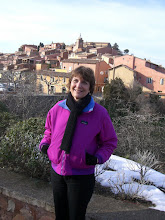
On tap for Thursday the 26th was a tour of the synagogue—la syna, as the guide Anne-Sophie referred to it—and a lecture on l’histoire et symbolique des rites alimentaires juifs (“the history and symbolism of Jewish food rituals”). But first, since at least two of us were not natives of the area, our guide told us a bit about the city itself. Its name comes from the word char (as in “cart”) because in the past Carpentras was a gathering place for farmers who transported their products there for sale. Anne-Sophie also pointed out that the locale has been inhabited since the Neolithic period and that Greeks from Marseille and Romans also occupied the area. There is, in fact, an arc de triomphe romain dating from the 1st century still standing in the city center. We also walked by la cathédrale Saint-Siffrein which, like many French churches, has elements of construction from several different centuries.
The church was also the starting point for the lecture about Jewish history in Carpentras. In the thirteenth century, a large region extending roughly from the Rhone to Mont Ventoux was sold to the papacy and became known then (as well as today) as le Comtat Venaissin, named after the town of Venasque. This independent state, protected by the Pope, became, to a certain extent, a haven for Jews expelled from other places like France. However, Jews in the area suffered various forms of censure. They were required to pay special taxes not demanded of others, to identify themselves by wearing red, and later on yellow (the latter being a color long associated with the marking of people like prostitutes as infâmes, “despicable”), and to attend Catholic services, entering through la porte juive (“the Jewish door”). At first they were forced to live outside the city ramparts and later they were confined to a dark, crowded place inside the walls called la carrière, from the Provençal word for “street.”

The synagogue, built in 1367, is the oldest Jewish place of worship in France. At the time of its construction, there were only about 90 Jewish families living in Carpentras. In the early eighteenth century the community had grown quite large, and authorization was given by Bishop d’Inguimbert to increase the size of the synagogue; the bishop, however, became incensed and demanded a change of plans when it appeared that the new edifice would be taller than the nearby cathedral. Today the interior is much as it was in the 1700s: there are chandeliers all around to symbolize the fact that Dieu, c’est la lumière (“God is light”); all of the
 walls are made of wood, though some of them look exactly like they are lined with marble; there is a small red chair in a niche on the wall which represents the coming of Eli during rites of circumcision.
walls are made of wood, though some of them look exactly like they are lined with marble; there is a small red chair in a niche on the wall which represents the coming of Eli during rites of circumcision. Anne-Sophie, who was quite knowledgeable, told us that a synagogue is a place of prière, étude et réunion (“prayer, study, and gathering”). She spent a lot of time, of course, describing food in the Jewish tradition: the various restrictions, preparations, and the need for multiple dishware, etc. It was interesting to hear about the importance of hygiene in food preparation and ritual washing, which many believe protected Jews from falling ill to the plague in the Middle Ages and their animals from being affected by la vache folle (“mad cow disease”) in the 1990s. All in all, it was a very pleasant and informative afternoon.

2 comments:
It is amazing to me that everything closes down in the afternoon but you can still catch a bus! Or, perhaps it was after the siesta period?!?
Very good comment, krps! Some things are open and buses continue to run during the siesta period. And you're right; we took a bus at 1:00 p.m. on a couple of days. Basically, cafés, restaurants, and other food services do continue to operate, as do the buses.
Post a Comment